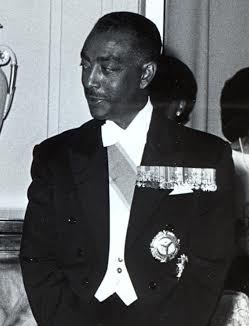Abiye Abebe facts for kids
Quick facts for kids
Abiye Abebe
|
|
|---|---|
|
አብይ አበበ
|
|

Abiye in 1967
|
|
| Minister of Defence | |
| In office 28 February 1974 – 22 July 1974 |
|
| Prime Minister | Endelkachew Makonnen |
| Preceded by | Merid Mengesha |
| Succeeded by | Aman Andom |
| President of the Senate | |
| In office 15 July 1964 – 28 February 1974 |
|
| Monarch | Haile Selassie I |
| Preceded by | Le'ul Ras Asrate Kassa |
| Succeeded by | Legislature abolished |
| Governor-General of Eritrea Chief Administrator (1960–1962) Chief Executive (1959–1960) |
|
| In office 20 May 1959 – 12 February 1964 |
|
| Monarch | Haile Selassie I |
| Preceded by | Bitwoded Asfaha Woldemikael as Chief Executive |
| Succeeded by | Le'ul Ras Asrate Kassa |
| Personal details | |
| Born | 1917 Addis Ababa, Ethiopian Empire |
| Died | 23 November 1974 (aged 56–57) Akaki Central Prison, Addis Ababa, Ethiopia |
| Spouses | Princess Tsehai Haile-Selassie Woizero Amarech Nasibu |
| Parent |
|
Abiye Abebe (born 1917 – 23 November 1974) was an important Ethiopian politician and a son-in-law of Emperor Haile Selassie. He held many key positions in the government, including serving as a minister and a governor.
Contents
Life and Career
Early Life and Education
Abiye Abebe was born in 1917 in Addis Ababa, the capital city of Ethiopia. His father was Liqa Mequas Abebe Atnaf Seggad, a respected figure. Abiye attended the Holeta Military Academy, where he trained to become a military leader.
Important Government Roles
During the 1940s and 1950s, Abiye Abebe served as the Minister of Defence. This meant he was in charge of Ethiopia's military forces. Later, he became the Minister of Justice, overseeing the country's legal system. He also served as the Minister of the Interior, which involved managing internal affairs and security.
From 1959 to 1964, he was the Governor-General of Eritrea, a region of Ethiopia at the time. This was a very important role, as he was responsible for leading the administration there.
Leadership in the Senate
Abiye Abebe also served as the President of the Ethiopian Senate from 1964 to 1974. The Senate was a key part of Ethiopia's parliament, where laws were discussed and approved. This position showed his influence and leadership in the government.
Political Changes and Later Life
In 1973, there were discussions about Abiye Abebe possibly becoming the Prime Minister. However, he wanted the Ethiopian parliament to approve his choice of cabinet members, which was not accepted by Emperor Haile Selassie. Because of this, Endelkachew Makonnen was appointed Prime Minister instead.
In 1974, during a time of big political change in Ethiopia, Abiye Abebe was serving as the Chief of the General Staff. He was arrested on July 16, 1974, by a group called the Derg. Sadly, he lost his life during this difficult political period on November 23, 1974.
Family Life
General Abiye Abebe was married three times. In 1942, he married Princess Tsehai of Ethiopia, who was Emperor Haile Selassie's daughter. Sadly, she passed away a year later. Even after her death, Abiye Abebe was still treated with the special respect given to the Emperor's son-in-law.
Later, in 1946, he married Woizero Amarech Nasibu. In 1970, he married Woizero Tsige Aynalem. He had three children with her: Phebe, Berkinesh, and Abiye.
Career Highlights
- 1942: Became a Brigadier-General.
- 1942–1943: Served as Governor-General of Wollega province.
- 1943–1947: Acting Minister for War.
- 1949–1955: Minister for War.
- 1955–1958: Ambassador to France.
- 1958–1961: Minister of Justice.
- 1959–1964: Viceroy of Eritrea.
- 1961–1964: Minister of Interior.
- 1964–1974: President of the Ethiopian Senate.
- February–July 1974: Minister for Defence and Chief of Staff.
Awards and Honours
Ethiopian Honours
 Knight Grand Cross of the Order of the Holy Trinity
Knight Grand Cross of the Order of the Holy Trinity Knight Grand Cross of the Order of Menelik II
Knight Grand Cross of the Order of Menelik II Military Medal of Merit of the Order of St George
Military Medal of Merit of the Order of St George Haile Selassie I Gold Medal
Haile Selassie I Gold Medal Patriot Medal & three torches (1944)
Patriot Medal & three torches (1944) Refugee Medal (1944)
Refugee Medal (1944) Jubilee Medal (1955)
Jubilee Medal (1955) Jubilee Medal (1966)
Jubilee Medal (1966)
International Honours
 Knight Grand Cross of the Order of Orange-Nassau (The Netherlands, 1953)
Knight Grand Cross of the Order of Orange-Nassau (The Netherlands, 1953) Knight Grand Cross of the Royal Norwegian Order of Saint Olav (Norway, 1956)
Knight Grand Cross of the Royal Norwegian Order of Saint Olav (Norway, 1956) Knight Grand Cross of the Order of Legion of Honour (France)
Knight Grand Cross of the Order of Legion of Honour (France) Grand Cordon of the Supreme Order of the Renaissance (Jordan)
Grand Cordon of the Supreme Order of the Renaissance (Jordan) Knight Grand Cross of the Royal Order of Sahametrei (Cambodia, 1968)
Knight Grand Cross of the Royal Order of Sahametrei (Cambodia, 1968) Honorary Knight Commander of the Order of the British Empire (United Kingdom, 1965)
Honorary Knight Commander of the Order of the British Empire (United Kingdom, 1965) British Star (United Kingdom, 1939–1945)
British Star (United Kingdom, 1939–1945) Africa Star (United Kingdom, 1940–1943)
Africa Star (United Kingdom, 1940–1943) British War Medal (United Kingdom, 1939–1945)
British War Medal (United Kingdom, 1939–1945) National Order of Merit (France)
National Order of Merit (France)

